- You are here:
- Home »
- Hazelwood
Tag Archives for " Hazelwood "
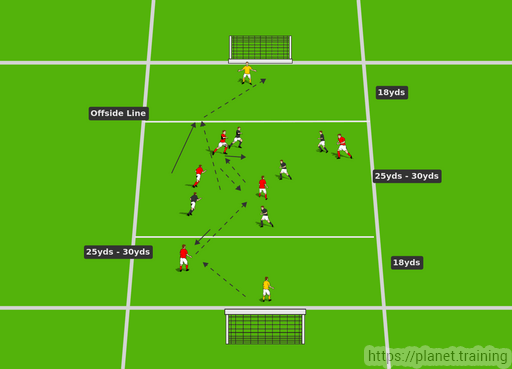
Receiving, Passing and Dribbling
By Anthony Hazelwood –
The ability to successfully control a ball during a receiving or dribbling action is crucial to meet individual and team tactical agendas. This activity aids the player to practice a first touch into a vacant space action and to follow it up with a dribbling change of direction activity.
Technical Activity:
Area Size:
Pair of red cones 1 yd. away from each other.
A pair of blue cones located left and right 5 yards away from the pair of red cones.
One yellow cone located 7 yds. above each pair of red cones (see diagram below).
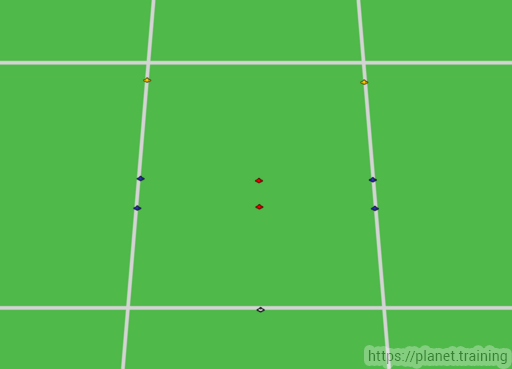
Total Activity Time: 10 minutes.
Sets: 1 set.
Activity Repetitions: 10 repetitions for each player.
Time of Activity Repetition per player: 30 seconds.
Intensity: Moderate.
Objectives:
Technique: Different receiving, dribbling, and passing variation patterns at moderately high ball speed.
Concentration Level: High.
Setup:
Players are placed into pairs. Each pair goes to a passing station.
Each passing station includes a pair of red cones one yd. away from each other.
A pair of blue cones located left and right 5 yards away from the pair of red cones.
One yellow cone located 7 yds. above each pair of red cones.
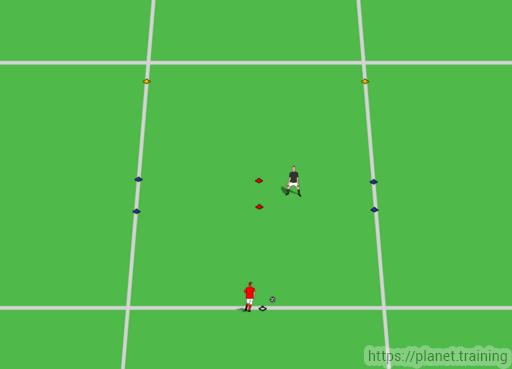
Exercise 1:
To start, the player on the black cone will pass to the teammate at the red cones.
The player in black will play a first touch (punch the ball) in between the red cones.
Then a dribbling action in between the two blue cones.
Once this is accomplished, the player will change directions and quickly dribble to the yellow cone go around it and make a pass to the teammate (see diagram below).
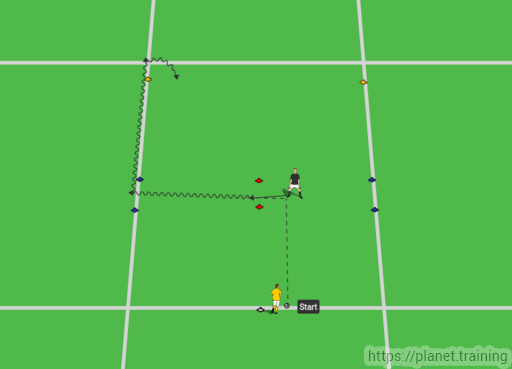
Once the ball is passed to the teammate, the yellow player will make a run to the starting space and perform the activity on the other side.
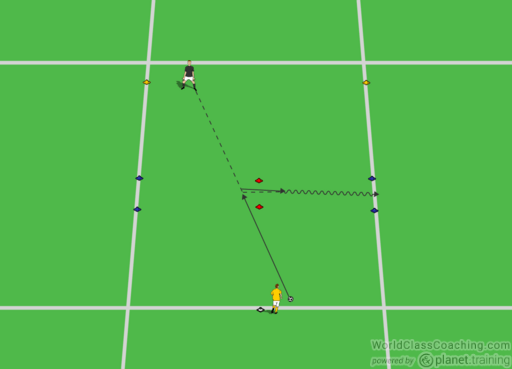
Each player repeats and performs the activity five times for 30 seconds with these variations.
Variation:
If variation is needed, then the routine may be performed with corporal restrictions.
Hands behind the back.
Hands behind the head.
Hands on shoulders.
Hands on hips.
Hands extended straight up into the air.
Coaching Points:
Make sure to practice receiving with different foot surfaces and to complete first touch and dribbling accuracy in between and around the cones.
Always alert and on their toes, focus is key.
By Anthony Hazelwood
Current Seattle Sounders Academy Performance Coach with previous European academy coaching experience as an assistant fitness and strength/conditioning soccer coach with Levante U.D. (2013-2014) and Getafe SAD CF (2015-2016) in Valencia and Madrid, Spain respectively. A USSF “A” licensed coach with a BSc in Physical Education and an MSc in Sports Training and Nutrition.
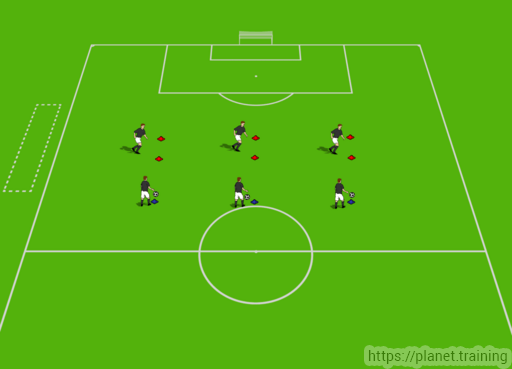
Individual Passing and Receiving
By Anthony Hazelwood –
Passing and receiving a soccer ball during a match is a penetrative or possession-based action between a pair of soccer players. The ability to perform these actions will be dictated by a decision-making process guided by the presented on-field scenarios. To solve these on-field situations, these two points should be considered:
• There is no one way to perform a technical execution.
• No action will ever be the same.
However, via individual biomechanical subjective actions, predominant passing and receiving technical executions will be performed by an athlete and mimicked more than others. Therefore, each player has a predominant reactional playing habit or neuromuscular behavioral pattern that is typically executed and in theory observed more than others.
To summarize, the scenario and tactical decision-making action will dictate a technical action to solve the soccer specific scenarios in a match or competitive practice setting. Therefore, adding variations in already learned technical execution patterns is important for player improvement to further solve in game situations.
Technical Activity:
• Area Size: Pair of red cones 1 yd. away from each other – blue cone located 3 yd. away from red cones.
• Total Activity Time: 20 minutes.
• Sets: 1 set.
• Activity Repetitions: 20 repetitions for each player.
• Time of Activity Repetition per player: 30 seconds.
• Intensity: Low to Moderate.
Objectives:
• Technique: Different passing and receiving variation patterns at moderately high ball speed.
• Concentration Level: Moderate.
Setup:
• Players are placed into pairs.
• Each pair goes to a passing station.
• Each passing station includes a pair of red cones one yd. away from each other.
• A blue cone is placed three yards away from the red paired cones.
• See below diagram for setup.
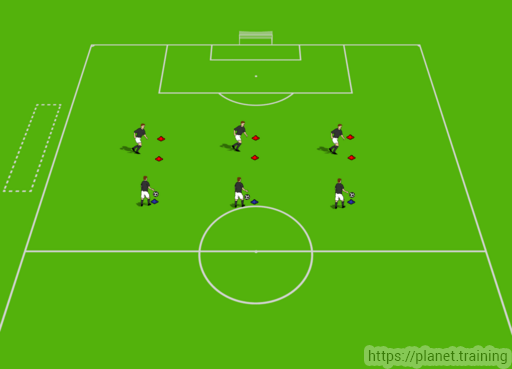
Exercise 1:
• To start, the player at the blue cone will pass to the teammate at the red cones.
• The objective for the player at the red cones will be to receive the ball and slightly punch the ball between the red cones.
• Once the ball goes in between the red cones, the player will quickly shift to the other side of the red cones and quickly pass the ball back to his teammate.
• The player at the red cones will now be on the other side of the cones and will repeat the same action on each side of the red cones.
• Each player repeats and performs the activity five times for 30 seconds with these variations.
o Hands behind the back.
o Hands behind the head.
o Hands on shoulders.
o Hands on hips.
o Hands extended straight up into the air.
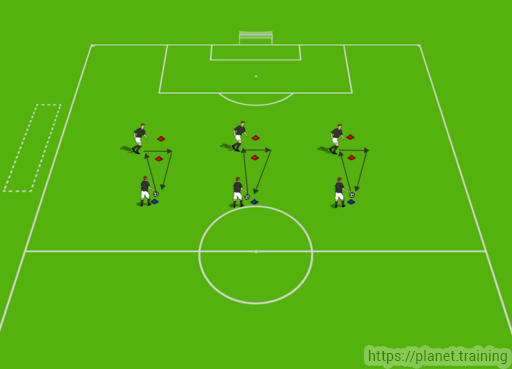
Exercise 2:
• To start, one player will have the ball and will stay central and between the paired cones.
• The objective for the other teammate is to one time pass the ball back at the left, in between and the right side of the paired cones (as seen below).
• Each player repeats and performs the activity five times for 30 seconds with these variations.
o Hands behind the back.
o Hands behind the head.
o Hands on shoulders.
o Hands on hips.
o Hands extended straight up into the air.
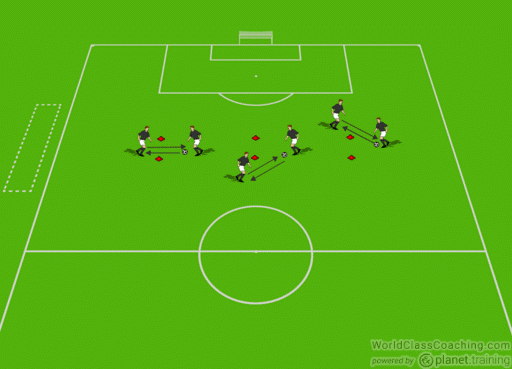
By Anthony Hazelwood
Current Seattle Sounders Academy Performance Coach with previous European academy coaching experience as an assistant fitness and strength/conditioning soccer coach with Levante U.D. (2013-2014) and Getafe SAD CF (2015-2016) in Valencia and Madrid, Spain respectively. A USSF “A” licensed coach with a BSc in Physical Education and an MSc in Sports Training and Nutrition.
